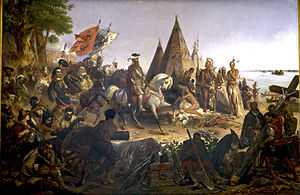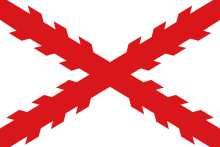Louisiana (New Spain)
| Government of Louisiana Luisiana | ||||||
| Territory of New Spain | ||||||
| ||||||
| ||||||
_orthographic_projection.svg.png) | ||||||
| Capital | Nueva Orleans | |||||
| History | ||||||
| - | Acquisition from France | 1762 | ||||
| - | Return to France | 15 October 1802 | ||||
| Political subdivisions | Upper Louisiana Lower Louisiana | |||||

Louisiana (Spanish: Luisiana, French: La Louisiane) was the name of an administrative district of the Viceroyalty of New Spain from 1762 to 1802 that represented territory west of the Mississippi River basin, plus New Orleans. Spain acquired the territory from France, who had named it La Louisiane in honor of their king Louis XIV in 1682.
History
Spain was largely a benign absentee landlord administering it from Havana, Cuba, and contracting out governing to people from many nationalities as long as they swore allegiance to Spain. During the American War of Independence, the Spanish funneled their supplies to the American revolutionists through New Orleans and the vast Louisiana territory beyond.
In keeping with being absentee landlords, Spanish efforts to turn Louisiana into a Spanish colony were usually fruitless. For instance, they succeeded in only making Spanish the official language of government, while the majority of the populace firmly continued to speak French. In fact the Louisianans forced the officials to speak French if they ever hoped to get anything accomplished.
Upper and Lower
The Spanish divided Louisiana into Upper Louisiana and Lower Louisiana at 36° 35' North, at about the latitude of New Madrid.[1]
This was a higher latitude than the French, for whom Lower Louisiana was the area south of about 31° North (the current northern boundary of the State of Louisiana) or the area south of where the Arkansas River joined the Mississippi at about 33° 46' North latitude.
Timeline
Spanish Exploration
- 1541 – Hernando de Soto, exploring from Florida, claimed the Mississippi and all its tributaries for the Spanish crown.
- 1541 – Francisco Vázquez de Coronado, exploring from Mexico for the Seven Cities of Gold, reached Lindsborg, Kansas.
French Control
- 1673 – Jacques Marquette and Louis Joliet began the exploration of the Mississippi descending from modern day Canada, and the French began to exert influence and claims over the territory.
- 1699 – Jean-Baptiste Le Moyne, Sieur de Bienville, started the first French settlement, at Fort Maurepas (now Ocean Springs, Mississippi).
- 1702 – Bienville moved French settlements to Dauphin Island and, in January, established Mobile colony, with Fort Louis at Twenty-Seven Mile Bluff (up the Mobile River).
- 1714 – Natchitoches was established by Louis Juchereau de St. Denis as part of French Louisiana; the community was named after the Natchitoches Indian tribe. The City of Natchitoches is the oldest permanent settlement in the Louisiana Purchase.
- 1718 – Bienville started construction of New Orleans, to move the capital of French Louisiana from Dauphin Island and Biloxi to the Mississippi River crescent, considered safer during hurricane tides.
- 1720 – The Spanish Villasur expedition, coming from Mexico, was slaughtered near Columbus, Nebraska, by Pawnees friendly to the French.
- 1723 – New Orleans became the third capital of French Louisiana.
- 1724 – Étienne de Veniard, Sieur de Bourgmont, held a council with the Commanche to resist Spanish expeditions coming from Mexico.
- 1754 – France and Great Britain began the French and Indian War.
- 1760 – Britain effectively controlled all of the French colonies in Quebec.
- 1761 – Spain sided with France in the expanded Seven Years' War.
Spanish Control



- 1762 – As negotiations began to end the Seven Years' War, Louis XV of France secretly proposed to his cousin Charles III of Spain that France give Louisiana to Spain in the Treaty of Fontainebleau.
- 1763 – The Treaty of Paris ended the war, with a provision in which France ceded all territory east of the Mississippi (including Canada) to Britain. Spain ceded Florida and land east of the Mississippi (including Baton Rouge, Louisiana) to Britain.
- 1763 – George III of the United Kingdom, in the Royal Proclamation of 1763, proclaimed that all land east of the Mississippi acquired in the war – with the exception of East Florida, West Florida and Quebec – would become an Indian Reserve.
- 1763 – The Acadian (Cajun) migration began, with French settlers from Quebec and settlers on the east side of the Mississippi who had been ordered to leave the new Indian Reserve migrating to Louisiana, which they believed was still French controlled land west of the Mississippi as well as New Orleans
- 1764 – Pierre Laclede established the Maxent and Laclede Company trading post at St. Louis, Missouri.
- 1764 – Spain's acquisition of Louisiana from France was formally announced.
- 1765 – Joseph Broussard led the first group of nearly 200 Acadians to settle on Bayou Teche below present-day St. Martinville, Louisiana.[2]
- 1768 – Antonio de Ulloa became the first Spanish governor of Louisiana. He did not fly the Spanish flag and was forced to leave by a pro-French mob in the Rebellion of 1768.
- 1769 – Alejandro O'Reilly suppressed the rebellion, executed its leaders and sent some plotters to prison in Morro Castle in Havana. He was otherwise benign and forgave other plotters as long as they swore allegiance to Spain. He established Spanish law and the cabildo of New Orleans.
- 1770 – Luis de Unzaga started the era of benign Spanish rule and freed the imprisoned plotters.
- 1770 – Spain began an administrative of process of governing Upper Louisiana with lieutenant governors.
- 1779 – Spanish settlers lead by Francisco Bouligny found Nueva Iberia along Bayou Teche.
- 1779 – Spain declared war on Great Britain in the American Revolutionary War and began the West Indies and Gulf Coast campaigns.
- 1780 – The Battle of Saint Louis was the only battle west of the Mississippi in the war.
- 1781 – The Spanish completed their reconquest of Florida in the Battle of Pensacola.
- 1783 – The Treaty of Paris officially returned control of Florida to Spain.
- 1788 – The Great New Orleans Fire destroyed virtually all of New Orleans. Governor Esteban Rodríguez Miró was a hero for his relief efforts.
- 1789 – Work on rebuilding New Orleans began, including what is now the French Quarter. The new structures had courtyards and stone walls. The cornerstone for the new St. Louis Cathedral was laid.
- 1795 – Pinckney's Treaty settled boundary disputes with the United States and recognized its right to navigate through New Orleans.
- 1795 – Spain began a series of scientific explorations of the Missouri River, including the MacKay and Evans Expedition.
- 1798 – Spain revoked the United States' right to travel through New Orleans.
- 1799 – The newly rebuilt Cabildo opened.
French Control
- 1800 – In the Third Treaty of San Ildefonso, Napoleon secretly acquired the territory, but Spain continued to administer it.
- 1801 – The United States was permitted again to use the port of New Orleans.
- 1803 – The purchase of Louisiana by the United States was announced.
- 1803 – Spain refused Lewis and Clark permission to travel up the Missouri River, since the transfer from France to the United States had not been made official; they spent the winter in Illinois at Camp Dubois.
- 1804 – France officially took control in November 1803, but word was not conveyed to St. Louis until 1804 on Three Flags Day.
References
- ↑ Reasonover, John R.; Michelle M. Haas (2005). Reasonover's Land Measures. Copano Bay Press. p. 41. ISBN 978-0-9767799-0-2.
- ↑ Bradshaw, Jim (27 January 1998). "Broussard named for early settler Valsin Broussard". Lafayette Daily Advertiser.

